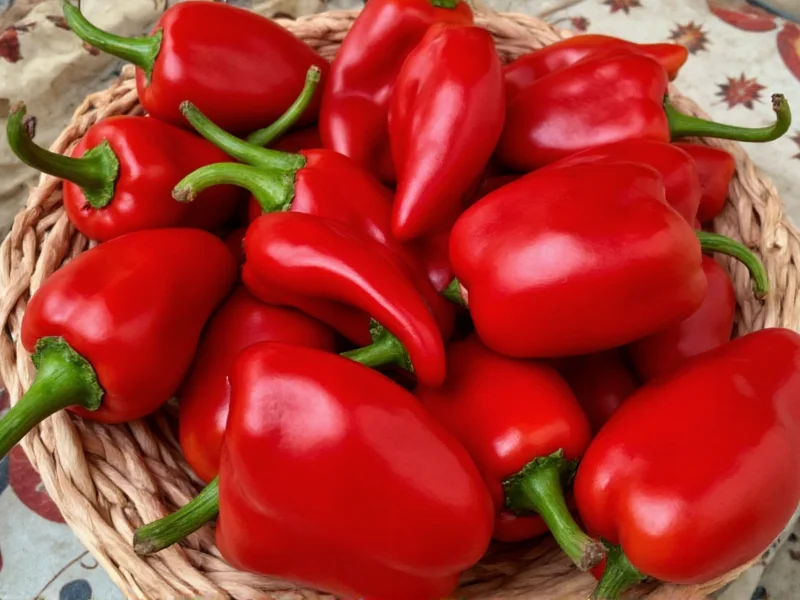Understanding the heat level of red poblano peppers requires examining their ripening process, growing conditions, and how they compare to other common peppers. As fully matured poblanos, red varieties develop slightly more heat than their green counterparts while gaining sweetness—a transformation that impacts both flavor profile and culinary applications.
What Makes Poblano Peppers Unique
Poblanos ( Capsicum annuum) originate from Puebla, Mexico, and serve as culinary staples in Mexican and Southwestern cuisine. When harvested green, they're commonly used in chiles rellenos and rajas. Left to fully ripen on the plant, they turn deep red and develop a richer, fruitier flavor profile while maintaining their characteristic mild heat.
Measuring Heat: The Scoville Scale Explained
The Scoville scale quantifies chili pepper heat by measuring capsaicin concentration—the compound responsible for spiciness. Developed by pharmacist Wilbur Scoville in 1912, this measurement system remains the industry standard despite modern laboratory methods.
Red poblanos consistently register between 1,000–2,000 Scoville Heat Units (SHU), placing them in the mild-to-medium category. For context, this means they're:
- 10–20 times milder than habaneros (100,000–350,000 SHU)
- Approximately 3–5 times milder than jalapeños (2,500–8,000 SHU)
- Slightly hotter than banana peppers (0–500 SHU) but milder than serranos (10,000–23,000 SHU)
| Pepper Variety | Scoville Heat Units | Heat Comparison |
|---|---|---|
| Red Poblano | 1,000–2,000 | Mild to medium |
| Green Poblano | 1,000–1,500 | Slightly milder than red |
| Jalapeño | 2,500–8,000 | 3–5 times hotter |
| Bell Pepper | 0 | No heat |
| Habanero | 100,000–350,000 | 50–350 times hotter |
Red vs. Green Poblanos: Heat Differences
Many home cooks wonder whether red poblano peppers are hotter than green ones. The answer involves understanding pepper maturation:
- Ripening process: As poblanos mature from green to red, sugar content increases while capsaicin levels slightly rise
- Typical heat range: Green poblanos average 1,000–1,500 SHU while red varieties reach 1,000–2,000 SHU
- Flavor transformation: Red poblanos develop complex notes of dried fruit and tobacco alongside increased sweetness
- Culinary impact: The slight heat increase in red poblanos is often masked by their enhanced sweetness
It's important to note that individual pepper heat can vary significantly based on growing conditions, soil composition, and water stress. A particularly stressed red poblano might occasionally reach 2,500 SHU, approaching mild jalapeño territory.
Factors Influencing Poblano Heat Levels
Several variables affect how hot your red poblano peppers might be:
Growing Conditions
Peppers develop more capsaicin when experiencing environmental stress. Drought conditions, temperature fluctuations, and nutrient-poor soil can increase heat levels by up to 30% compared to peppers grown in optimal conditions.
Preparation Methods
The heat distribution within poblano peppers isn't uniform. The placental tissue (white ribs and seeds) contains the highest concentration of capsaicin. Removing these parts can reduce perceived heat by 50–70% while preserving flavor.
Individual Sensitivity
Genetic factors influence capsaicin sensitivity. Some people naturally possess more TRPV1 receptors (which detect capsaicin), making the same pepper feel significantly hotter to them than to others.
Culinary Applications for Red Poblanos
Understanding red poblano heat levels helps optimize their use in cooking:
- Roasting and peeling: Enhances sweetness while slightly mellowing heat—ideal for chiles rellenos or cream-based sauces
- Drying process: When dried, red poblanos become ancho peppers with concentrated flavor and slightly intensified heat (1,000–2,500 SHU)
- Pairing suggestions: Complement their mild heat with dairy (sour cream, cheese), acidity (lime juice), or sweetness (roasted corn, plantains)
- Substitution guidance: Can replace green poblanos in most recipes with slightly deeper flavor; use half the quantity when substituting for hotter peppers like jalapeños
Common Misconceptions About Poblano Heat
Several myths persist about poblano pepper heat:
- Myth: Red poblanos are dramatically hotter than green ones
Reality: The difference is subtle—typically within 500 SHU - Myth: All poblanos have consistent heat levels
Reality: Natural variation means two peppers from the same plant can differ significantly - Myth: Size determines heat (smaller = hotter)
Reality: No scientific correlation exists between size and Scoville rating in poblanos
When selecting red poblanos at the market, look for firm, glossy skins without wrinkles or soft spots. The deepest red specimens often indicate full ripeness and optimal flavor development, though color intensity doesn't directly correlate with heat level.
Frequently Asked Questions
How much hotter are red poblanos compared to green poblanos?
Red poblanos are typically 20-30% hotter than green poblanos, averaging 1,000-2,000 Scoville units compared to green's 1,000-1,500. However, the increased sweetness in red varieties often masks this slight heat difference during consumption.
Can red poblano peppers ever be as hot as jalapeños?
While extremely rare, stressed growing conditions can occasionally push red poblanos to 2,500 Scoville units—the lower range of jalapeño heat (2,500-8,000 SHU). Most red poblanos remain significantly milder than even the mildest jalapeños.
Why do some red poblano peppers taste hotter than others?
Natural variation in capsaicin production occurs due to growing conditions, plant genetics, and individual pepper maturity. Water stress, temperature fluctuations, and soil composition significantly impact heat levels, causing noticeable differences even between peppers from the same plant.
Do red poblano peppers get hotter when cooked?
Cooking doesn't increase capsaicin levels, but it does release more capsaicin from the pepper's structure, potentially making the heat more noticeable. Roasting specifically enhances sweetness which can balance perceived heat. Removing seeds and membranes before cooking reduces heat intensity significantly.
Are dried red poblanos (ancho peppers) hotter than fresh?
Dried ancho peppers typically register slightly higher on the Scoville scale (1,000-2,500 SHU) than fresh red poblanos due to water removal concentrating capsaicin. However, the drying process also develops complex sweet and smoky flavors that balance the heat perception.











 浙公网安备
33010002000092号
浙公网安备
33010002000092号 浙B2-20120091-4
浙B2-20120091-4